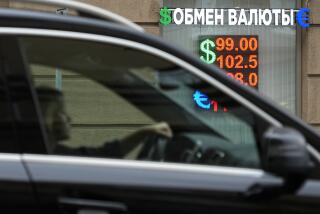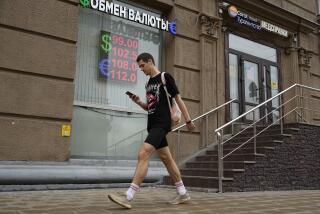Coupons Replace Rubles in Ukraine : Currency: Soviet paper money becomes worthless overnight in state-run stores. The move seems sure to heighten tensions with Russia.
- Share via
KIEV, Ukraine — The Ukrainian government began extracting the country from what remains of the disintegrating Soviet economy with the introduction Friday of reusable coupons--effectively a new currency to replace the old ruble.
Soviet paper money became worthless overnight in state-run Ukrainian stores where most urban Ukrainians shop for food, clothing and household goods; the new scrip will be the only acceptable cash there until a full-fledged Ukrainian currency is issued this summer.
Within hours, the coupons--officially karbovantsy , the old Ukrainian name for a ruble--were worth 10 to 15 times the value of their Russian counterparts, because goods in the state stores could only be bought with them.
The value of the coupons in terms of U.S. dollars or other foreign currencies was not set on Friday, although speculators were buying as many as they could at roughly 5 to 7 cents each, expecting the value to rise quickly.
One of its boldest steps in implementing its decision to become fully independent, Ukraine’s introduction of the coupons seemed certain to heighten tensions with Russia, with which it is already quarreling over the division of the Soviet armed forces.
By virtue of its size, Russia continues to dominate the economy of the Commonwealth of Independent States, a grouping of 11 former Soviet republics. Moscow has warned that such scrip as that of Ukraine and ration books like those of Belarus will undermine the value of the ruble throughout what is supposed to be a common market with a common currency.
But Ukrainian officials said that, despite many promises, the Russian-run state mint in Moscow failed to deliver enough bank notes to pay monthly wages after the increase in prices for food and most consumer goods last week.
Issued to workers as part of their wages in place of the rubles that never arrived from Moscow, the coupons also act as a form of rationing, protecting Ukraine’s rapidly emptying shelves from ruble-rich Russian “shopping paratroopers” whose purchasing exploits have been widely reported in the Ukrainian media.
Initially, 25% of wages were to be paid in coupons with a maximum of 400 rubles a month. On Friday, the amount was raised to 75% with a maximum of 600 rubles. But the change did not reassure buyers at the Gastronom on Kiev’s central Khreshchatyk Boulevard.
“How can we live on 300 coupons?” one angry woman demanded. “A kilogram of meat and a packet of sour cream uses up half of that.”
The woman’s concern is shared by radical Ukrainian economists. Oleksandr Savchenko, vice president of the Ukrainian Central Bank, complained this week that “the government made a mistake in raising prices under the old currency. Now, there aren’t enough coupons to keep up with inflation.”
If coupons were the only currency for everything, prices would eventually fall to match the amount of money in buyers’ wallets, and that would be positive, Savchenko said. But if rubles are still acceptable for some payments in Ukraine, he continued, they will still be acceptable on the black market, inflating prices beyond regulatory controls.
One prospect is a reversal in the predatory shopping pattern so that Ukrainians, finding their rubles worthless at home, will travel to Russia to buy whatever can be found there.
But on Friday, the Russian government announced that items in short supply--such as certain foods, alcohol, tobacco, fabric, shoes and household appliances--cannot be sent or taken to other former Soviet republics.
A Tass news agency report said that travelers from other republics would be checked at the borders.
Savchenko said he hopes that Ukraine will be using only coupons by February. If not, he says, “This could lead to a financial crisis.”
Under current regulations, cash rubles can still be used officially to pay for transactions that do not involve groceries or manufactured goods, such as rents, utilities, transportation, restaurants and newspapers. They can also be used in stores that sell imported items second-hand at Western prices and for major purchases of items costing more than 2,000 rubles.
Special correspondent Mycio reports from Kiev for The Times.
More to Read
Sign up for Essential California
The most important California stories and recommendations in your inbox every morning.
You may occasionally receive promotional content from the Los Angeles Times.












